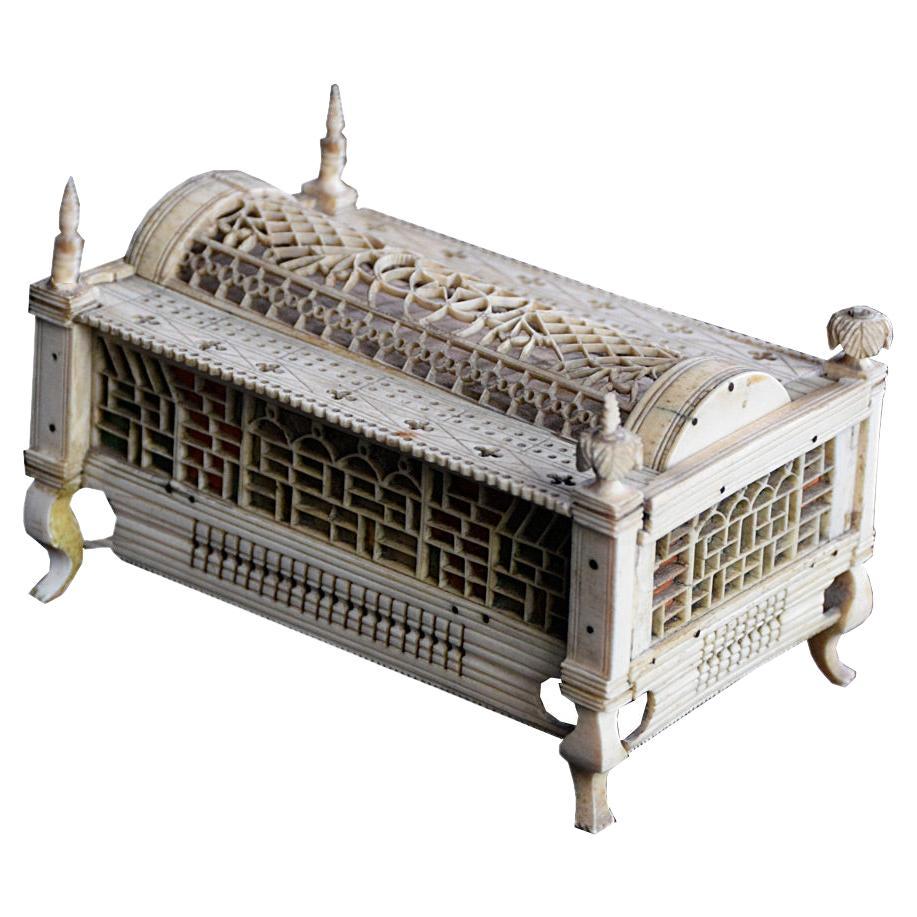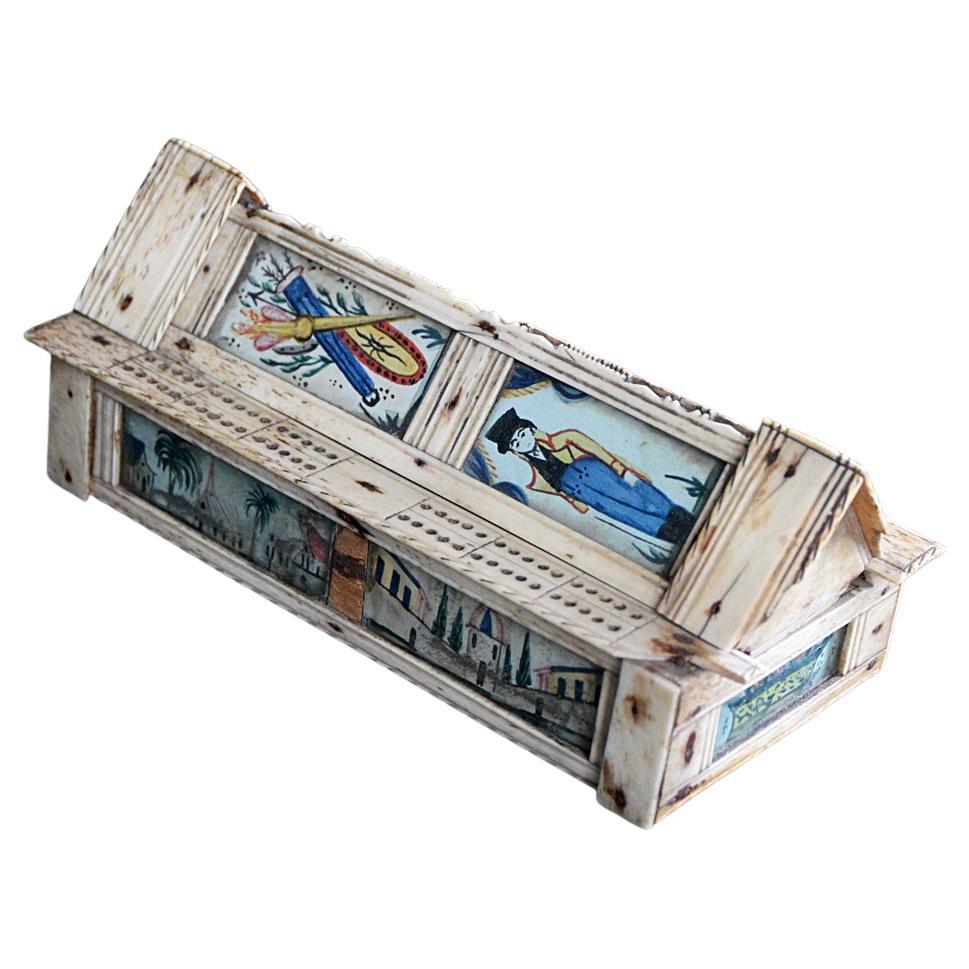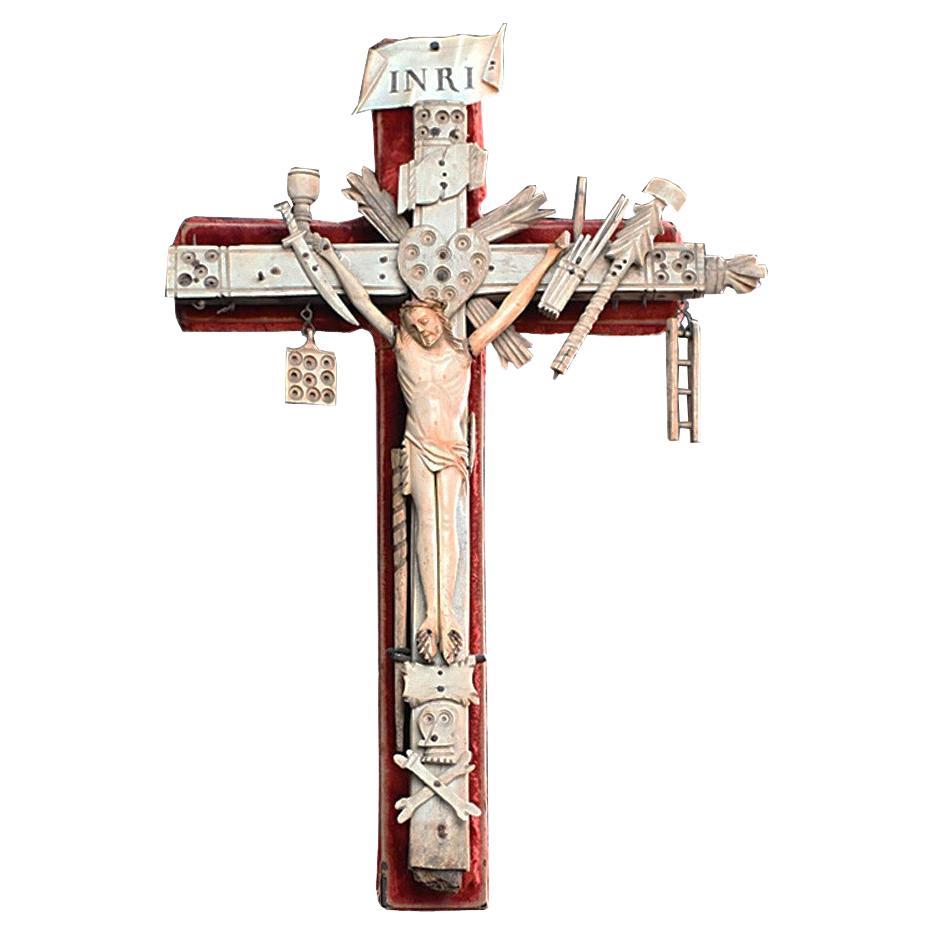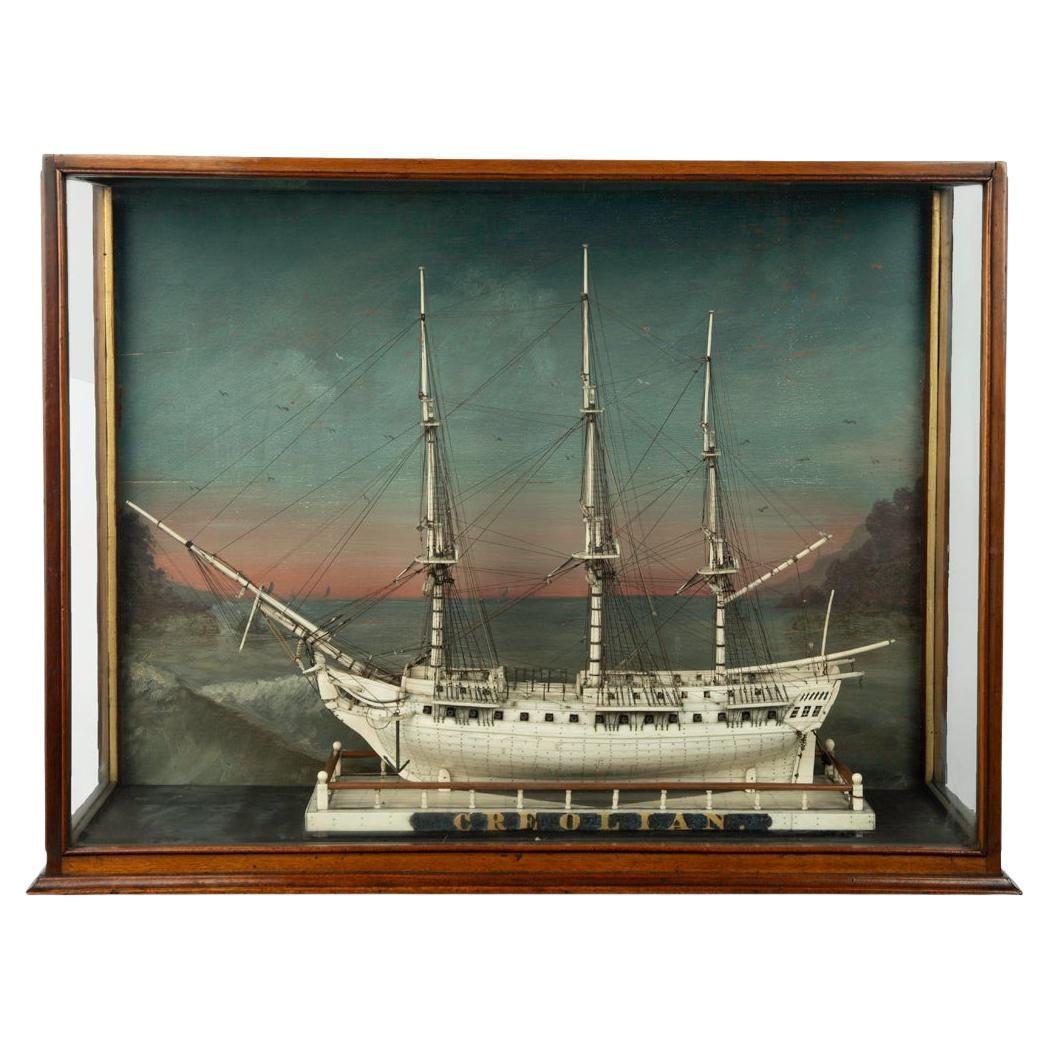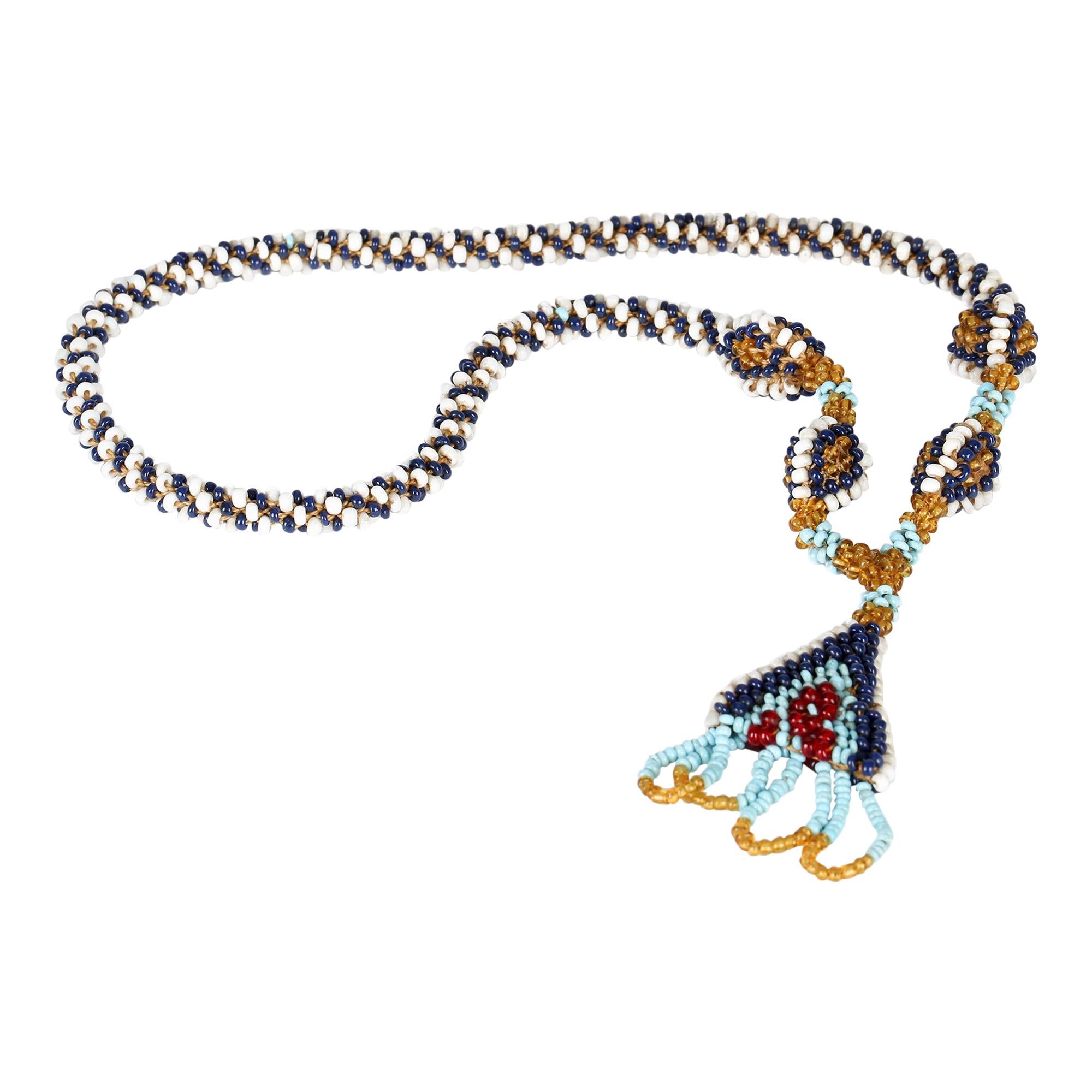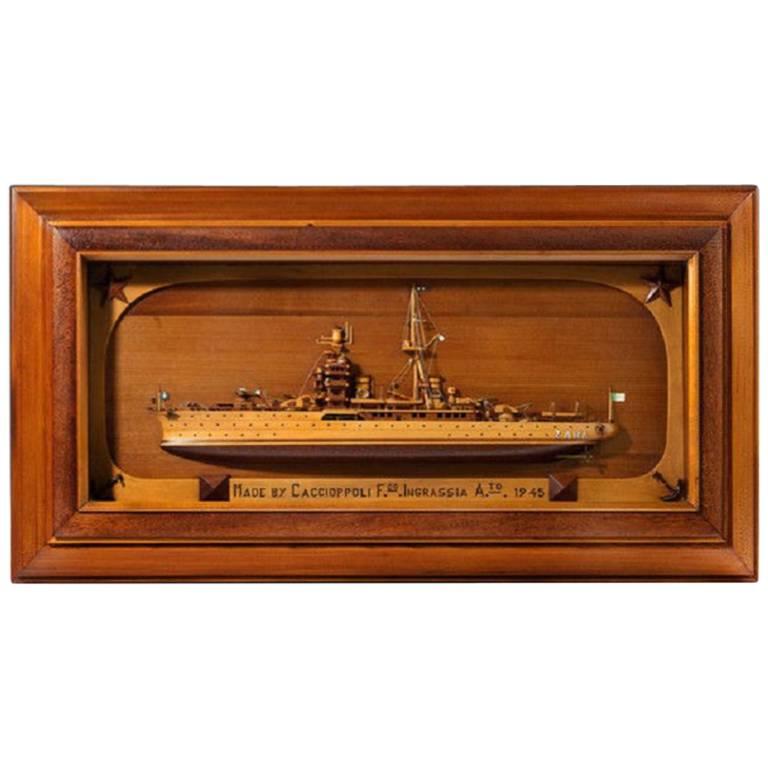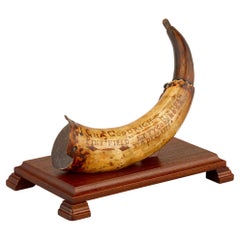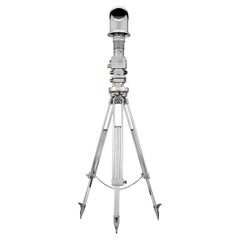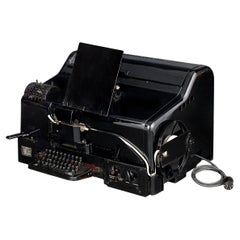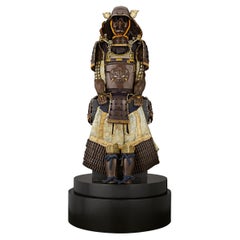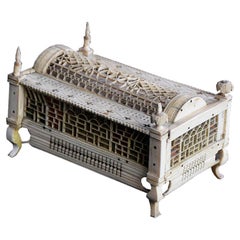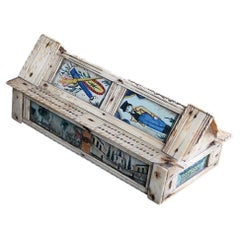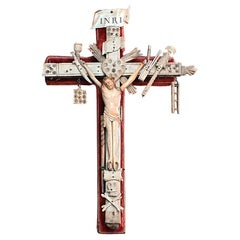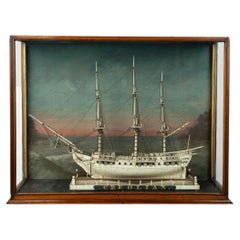Items Similar to Napoleonic Prisoner-of-War Guillotine
Want more images or videos?
Request additional images or videos from the seller
1 of 10
Napoleonic Prisoner-of-War Guillotine
About the Item
An incredible and extremely rare artifact of world history, this mutton bone model of a guillotine was created during the Napoleonic wars by a French prisoner of war. Many of the inmates at the prisoner of war camps were skilled artisans long before they were soldiers, and because of the long duration of the conflict and cost of care, their captors encouraged detainees to use their skills to create objects to be sold at civilian open markets. Because of the intricacy of these fascinating objets d'art, very few of these models have survived the test of time. This masterpiece is impeccably detailed with soldiers and cannons lining the platforms. Adding to the rarity of this piece is that it has moving parts, as only a scant few model carvings were ever created with such mechanical accuracy. The soldiers have movable arms, while the guillotine features a movable "blade" for added authenticity.
By many accounts, Napoleonic prisoners of war were confined to mostly makeshift prisons in old castles, naval dockyards and purpose built camps. Though treated fairly well, prisoners were typically kept in rather dark conditions and were not allowed to have objects that could be used as weapons, including tools. That means inmates would have had to create these amazing models using handmade tools made of whatever was available, including shards of glass for carving. Additionally, this activity was most likely done by candlelight. With this perspective, the precision and intricacy of this model becomes even more incredible.
Circa 1810
Measures: 7 5/8" wide x 10 1/4" deep x 18" high
With stand: 9 1/2" wide x 11 3/4" deep x 20 1/2" high.
- Dimensions:Height: 18 in (45.72 cm)Width: 7.63 in (19.39 cm)Depth: 10.25 in (26.04 cm)
- Materials and Techniques:
- Place of Origin:
- Period:
- Date of Manufacture:circa 1810
- Condition:
- Seller Location:New Orleans, LA
- Reference Number:Seller: 31-51041stDibs: LU891129946442
About the Seller
5.0
Recognized Seller
These prestigious sellers are industry leaders and represent the highest echelon for item quality and design.
Established in 1912
1stDibs seller since 2010
105 sales on 1stDibs
Typical response time: 11 hours
- ShippingRetrieving quote...Shipping from: New Orleans, LA
- Return Policy
Authenticity Guarantee
In the unlikely event there’s an issue with an item’s authenticity, contact us within 1 year for a full refund. DetailsMoney-Back Guarantee
If your item is not as described, is damaged in transit, or does not arrive, contact us within 7 days for a full refund. Details24-Hour Cancellation
You have a 24-hour grace period in which to reconsider your purchase, with no questions asked.Vetted Professional Sellers
Our world-class sellers must adhere to strict standards for service and quality, maintaining the integrity of our listings.Price-Match Guarantee
If you find that a seller listed the same item for a lower price elsewhere, we’ll match it.Trusted Global Delivery
Our best-in-class carrier network provides specialized shipping options worldwide, including custom delivery.More From This Seller
View AllRevolutionary War Powder Horn
Located in New Orleans, LA
Powder Horn
Engraving by Charles Goodrich
1776
Powder horns stand among the rarest and most treasured forms of American folk art. Unlike commercial objects, these deeply personal items were crafted by soldiers, sailors and explorers for practical use during their journeys. Through scrimshaw—an intricate technique of engraving bone or horn with a simple jackknife and filling the crevices with available pigments like soot or ash—these individuals left tangible marks of their hopes, dreams and experiences. This exceptional American Revolutionary War powder horn belonged to Charles Goodrich (1720-1816), a significant figure in early Pittsfield, Massachusetts history. The horn displays distinctive period characteristics with the inscription "PITTSFIELD" clearly visible on its amber-colored surface.
Charles Goodrich, born in Wethersfield, Connecticut in 1720, became a prominent civic leader in Pittsfield. He built the first house in the settlement in 1754 and served in various official roles, including Justice of the Peace and town representative to Boston. While Goodrich's name may not appear prominently in history textbooks, historical documents—particularly his September 3, 1776 petition to the Massachusetts Assembly—reveal his compelling story. The petition shows that Goodrich faced accusations of being a British sympathizer and draft evader. According to his account, he was targeted for his public office, physically assaulted by a man named James Morey and subsequently fined by a local committee. Goodrich maintained that he merely defended himself when attacked and claimed ignorance of requirements to either serve as a drafted soldier or hire a substitute—accusations that branded him unpatriotic during the revolutionary fervor.
The Massachusetts Council's concurrence with Goodrich's petition likely inspired his subsequent military service. His powder horn, bearing the inscription of Pittsfield, accompanied him to Fort Ticonderoga, where Simonds' Regiment of Militia (2nd Berkshire County Regiment) was stationed during the difficult winter of 1776-1777. Fort Ticonderoga, a strategic stronghold in upstate New York, had been seized from the British in May 1775 by Ethan Allen and Benedict Arnold. By the time of Goodrich's service, American forces occupied the fort while preparing for an expected British counterattack. In August 1777, Goodrich and Simonds' Regiment participated in the Battle of Bennington—a decisive engagement where Patriot forces under General John Stark defeated British and Hessian troops. This victory significantly weakened General John Burgoyne's invasion force, contributing to his surrender at Saratoga in October 1777—a pivotal turning point that helped secure French support for the American cause.
Powder horns captivate elite collectors and major museums alike. The Metropolitan Museum of Art recognized their significance by dedicating an entire exhibition to American Engraved Powder Horns...
Category
Antique 18th Century American American Colonial Historical Memorabilia
Materials
Horn
Carl Zeiss Cold War Binocular Periscope
By Carl Zeiss
Located in New Orleans, LA
Binocular Periscope
Carl Zeiss
Circa 1965
This exceptional binocular periscope, crafted by the renowned Carl Zeiss optical works, represents the pinnacle of mid-20th century German ...
Category
20th Century German Historical Memorabilia
Materials
Metal
World War II Ten-Rotor T52 Enigma Machine
Located in New Orleans, LA
Ten-Rotor T52 "Geheimschreiber" Cipher Machine
Dated 1944
This extraordinary Ten-Rotor T52 Cipher Machine, also known as the Geheimschreiber, represents the pinnacle of German warti...
Category
20th Century German Historical Memorabilia
Materials
Metal
Edo Period Samurai Suit Of Armor
Located in New Orleans, LA
This exquisite Tetsusabiji Uchidashi Gomai Dou Gusoku (Five-Plate Russet Iron Embossed Cuirass Armor), crafted in the 18th century, exemplifies the pinnacle of Edo-period samurai arm...
Category
Antique 18th Century Asian Edo Arms, Armor and Weapons
Materials
Copper, Iron
$188,500
Coronation of Queen Elizabeth II Commemorative Glass
Located in New Orleans, LA
This engraved glass was crafted to commemorate the coronation of Queen Elizabeth II. Sixteen years following the coronation of her father, King George VI, the official coronation of Queen Elizabeth II represented a fascinating mix of tradition and modernity. Held at Westminster Abbey, it was the first official celebration of its kind ever to be televised — approximately 27 million people in the United Kingdom alone tuned in to watch their new Queen don her crown for the first time. Considering the widespread popularity of the event, commemorative objects such as this became highly desirable, as people around the world sought remembrances of the joyous occasion.
This glass is an exceptional example of its type that remains in excellent condition. One side reads "The Coronation of Queen Elizabeth 1953," while the other displays the initials "ER II...
Category
20th Century English Historical Memorabilia
Materials
Glass
English Stick Barometer by Worthington of London
Located in New Orleans, LA
This exceptional English stick barometer is a classic example of these intriguing meteorological instruments. Crafted by the esteemed Worthington & All...
Category
Antique 19th Century English Georgian Scientific Instruments
Materials
Mahogany
You May Also Like
Napoleonic Prisoner of War Casket Dominoes Set
Located in London, GB
Napoleonic Prisoner of war casket Dominoes set
We share what we love, and we love this early 19th century Napoleonic prisoner of war cask...
Category
Antique 1820s French Folk Art Toys
Materials
Bone
Napoleonic Prisoner of War Painted Casket Dominoes Set
Located in London, GB
Napoleonic Prisoner of war painted casket dominoes set
We share what we love, and we love this early 19th century Napoleonic prisoner of war hand painted ...
Category
Antique 19th Century French Folk Art Game Boards
Materials
Bone
19th Century Napoleonic Prisoner of War Folk Art Corpus
Located in London, GB
19th century Napoleonic Prisoner of War Folk art Corpus
A rare and unusual example of a 19th Century hand crafted Napoleonic folk art prisoner of war corpus Christi. Later added ...
Category
Antique 19th Century Unknown Folk Art Religious Items
Materials
Bone
A Napoleonic era bone prisoner of war model of the 40-gun frigate ‘Creolian’
Located in Lymington, Hampshire
A Napoleonic era bone prisoner of war model of the 40-gun frigate ‘Creolian’, the three masted barque with a planked hull, finely detailed with a carved poop deck and a female figurehead, intricate black thread rigging and a black plaque stating in gilt, Creolian. In the original glazed wooden case with a painted background of a sunset over a bay with ships on the horizon. French, circa 1800.
Provenance Ivan Roll Amis, d. 1 July 1970
Richard Henry Allen Amis, CBE, thence by descent
During the Revolutionary and Napoleonic Wars (1793-1815), large numbers of French soldiers and marines were taken prisoner. To help pass the time and generate a small income, they would make a variety of objects—including ship models—from simple, easily-sourced materials such as bone and wood for sale at local markets. Typically, the models were not made to scale and tools were limited, making the quality and attention to detail in this work even more remarkable. To realise a good price at market, the models were often named after famous ships of the time. It may well be that this ship was the ‘Créole’, a 40-gun frigate of the French Navy. She served in the Brest squadron, took part in Ganteaume’s expeditions of 1801 to Egypt, and was involved in the French acquisition of Santo Domingo (also known as the Era de Francia) and briefly detained Toussaint Louverture...
Category
Antique 19th Century French Nautical Objects
Materials
Bone, Wood
Turkish WWI Prisoner of War Glass Beadwork Amulet Necklace
Located in Bishop's Stortford, Hertfordshire
An exceptionally good quality Turkish prisoner of war glass beadwork amulet necklace dating from the first world war 1914-1919. These pieces were made by Turkish prisoners of war, ca...
Category
Vintage 1910s Turkish Folk Art Collectible Jewelry
Materials
Glass
Rare WWII Italian Prisoner of War Work Model of Italian Cruiser 'Zara'
Located in Lymington, Hampshire
Rare WWII Italian Prisoner of war work model of Italian heavy cruiser 'Zara' with finely detailed superstructure and armament in a cedar and pine glazed c...
Category
